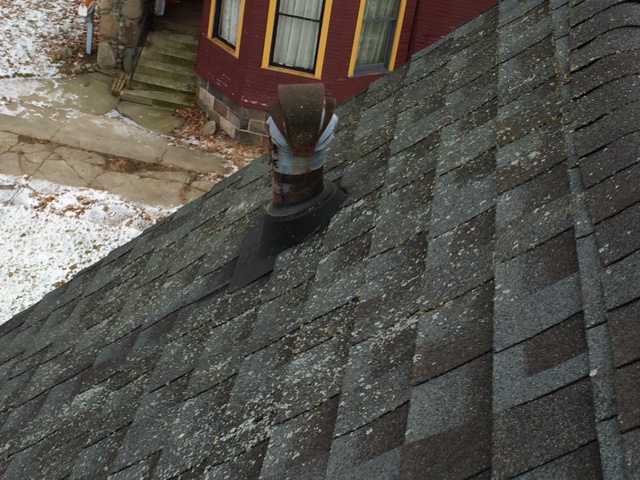Cleaning Your Shingles
- Darrin Card

- Feb 6, 2019
- 4 min read
Of all the items I see on my home inspections one of the most prevalent has to be shingles which are being slowly destroyed by moss, algae, and other microbial infestations. Many asphalt shingled roofs I see have fungal growth and even more have black streaks running down them. Most people recognize the green “hairy” growth for what it is, algae, but many people don’t realize that the most prevalent reason they get black streaks on their roof is due to another type of blue-green algae known as Gloeocapsa Magma that is spread by airborne spores. The infestation of Gleocapsa Magma usually begins on the area of the roof that gets the least amount of sun or areas that stay moist longer like valleys or shaded areas under trees. Overtime the algae will grow and spread until it covers the entire roof.
According to Atlas Roofing, a major manufacturer of roofing material, “If it isn’t stopped, the infestation of algae will cause severe damage and shorten a roof’s useful life. In addition it will lead to increased energy costs and reduce a house’s market value through loss of curb appeal.” (https://www.atlasroofing.com/news/article/Atlas+Roofing+Fights+Epidemic+Of+Gloeocapsa+Magma). Over time the algae eat away at the gypsum filler used in the shingles, a additive that has became more prevalent in shingles for about the last 10 years. The loss of the limestone reduces the weight of the shingles, making it more susceptible to granular loss which in turn leads to an overheating of the shingles and exposure of the substrate to UV rays both of which lead to a premature failure of the shingle. Even worse this type of algae can lead to further forms of algae growth on the roof, as they have an easier time taking hold. When performing home inspections I often see mold, lichens, and moss growing in roofs which display a large area of Gloeocapsa Magma. They act like sponges on the shingles, holding moisture and causing more growth and further damage to the roof. Furthermore these additional types may cause the roof to become more susceptible to wind damage and hail damage.
Algae Resistant Shingles
Shingle manufacturers, such as Atlas, have recently started manufacturing algae resistant shingles. By adding copper granules into the shingles they are able to stop the growth of algae. If you live in an area which has a probability of algae growth like near a lake or on a shaded lot, be sure to ask for this type of shingle when replacing your roof.
Algae Prevention
Preventing algae growth can save you lots of time in the long run. Roofs may need to be treated multiple times per year for algae growth and each treatment can be time consuming and labor intensive. Prevention is the key. To prevent algae growth I recommend installing a strip of copper flashing along the entire ridge near the top of the roof leaving 2-4” of it exposed. The chemicals in the copper will wash down the roof during rains, preventing algae growth over a long period of time. I have used this method for algae control personally and found it works well. Zinc flashing also works, however I believe the copper does a better job.
How To Clean Your Roof
Cleaning your roof is an annual or bi-annual chore if you are susceptible to algae growth, however it is well worth the effort in order to prolong the life of your roof. Never use a pressure washer on your roof, it is too harsh and could damage the shingles or shorten their lifespan. If moss or lichens are growing on your roof you may have to use a soft bristled brush to remove them. Be sure to brush down the roof, never up the roof as you could loosen the shingles bonds and make them more susceptible to wind damage. Brush softly until the algae is removed, hard brushing can remove the granules from the shingles, causing premature failure.
While there are home made formulas that can be used to make your own roof cleaning solution I opt for a store bought option specifically designed to be used on asphalt shingles. I have found they tend to be less chemically abrasive to the shingles and keep the algae off the roof longer meaning less frequent treatments. Store bought chemicals include Spray and Forget by Generac and Zinsser’s Jomax. These chemicals are most often applied using a pump sprayer and then washed off with a hose. Spray and Forget also makes container that hooks directly to your hose which is convenient and, in my opinion, the best option out there for a typical homeowner.
It is important to remove and clean your roof if algae is present, however if there are no visible signs please do not put chemicals on the roof. Even specialized cleaners can have a damaging effect over time. Always remember to follow good safety practices and manufacturers safety instructions when working on a roof or with chemicals. Manufacturers directions should be read and followed before attempting any type of cleaning. And as always, if you have any questions about cleaning a roof don’t hesitate to leave a comment below!




















This work must be done by professional roof repair contractors as they know how and in what manner the cleaning must be done.